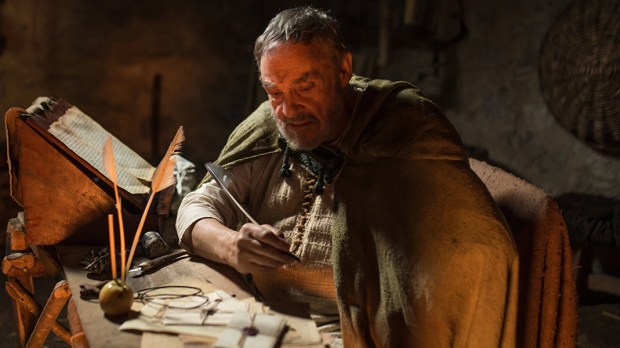Lenten Campaign 2025
This content is free of charge, as are all our articles.
Support us with a donation that is tax-deductible and enable us to continue to reach millions of readers.
There are two main problems with the Christian Broadcasting Network’s new docudrama I Am Patrick. The first one is that they hired John Rhys-Davies to portray the elderly saint as he sits down to write his memoirs, the Confessio. Now, the trouble is not with the actor, per se, because it’s unlikely a thespian can get much more beloved than the guy who played both Gimli and Indiana Jones’ sidekick. The dilemma is that Rhys-Davies is so compelling in the role that viewers will likely end up wanting to see more of him rather than all the flashbacks and talking heads that make up the bulk of the film’s running time.
Those cutaways are necessary, though, because of the film’s second problem. That is convincing audiences who might think they already know everything about the saint that there’s still lots left to learn. After all, everyone has already heard all the important stuff about Patrick, right? Basically, he’s that Irish guy who chased away snakes, held a clover leaf while he preached, and kickstarted a holiday that revolves around a lot of drinking. The thing is, some of that is just legend and the rest is flat out wrong. He wasn’t even Irish, for crying out loud. So, a movie which gets to the truth about Patrick’s life is actually a fine idea.
It starts, appropriately enough, with the aged cleric penning the opening lines to his Confessio. They read, “My name is Patrick. I am a sinner, a simple country person, and the least of all believers. I am looked down upon by many. My father was Calpornius. He was a deacon; his father was Potitus, a priest, who lived at Bannavem Taburniae. His home was near there, and that is where I was taken prisoner. I was about sixteen at the time.”
Yes, Patrick’s story begins with him in chains. Captured and sold by raiders who ransacked the Roman villa in Britain where he grew up, the future saint would spend nearly seven years in slavery in Ireland. After gaining his freedom with a little assist from up above, Patrick was educated and ordained as a priest. This calling would eventually lead him back to the Emerald Isle, where he would serve as a missionary to the very people who had previously held him in bondage.
You just never know where God is going to lead you, which is in many ways the overarching theme of the documentary. Through its historical recreations and interviews with experts on the subject matter, the film covers Patrick’s journey from pagan prisoner to powerhouse preacher, a journey that often met with opposition from both outside and, surprisingly, inside the Church.
One of the more interesting sections of the film covers Patrick’s clashes with some British bishops who felt the fledgling missionary was using methods they considered too unorthodox, such as preaching in the vernacular rather than Latin and ordaining priests despite his own relative inexperience. The movie, made primarily by Protestants, seems to evidence a little glee over these instances of Patrick butting heads with the hierarchy, but it does concede that he acknowledged his faults and pledged obedience to the Church. That was, after all, the entire reason he wrote the Confessio to begin with.
In the end, the film is a celebration of Patrick’s willingness to accept and endure whatever God required of him. Though the pathway the Lord set before the soon-to-be-saint was often rocky and twisting, Patrick’s trust in God’s guidance would eventually lead to the conversion of an entire country. And yes, to a few legends along the way as well, but I Am Patrick can help set the record straight on those.
I Am Patrick makes its way to the big screen on March 17 and 18 in theaters across the country that host Fathom events.

